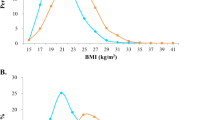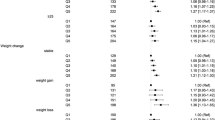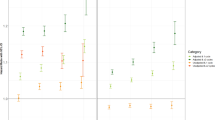Abstract
Background/Objectives:
The objective of this study was to quantify body weight changes in German adult populations during the past decades.
Subjects/Methods:
Longitudinal analysis of seven cohort studies covering different age ranges between 18 and 83 years. Baseline examinations were between 1994 and 2007 and follow-up durations between 4.0 and 11.9 years. For each study, mean change in body weight per year and 10-year change in body mass index (BMI) classification were analyzed. For the middle age group of 45–64 years, meta-analysis was conducted to obtain an overall estimate for Germany.
Results:
Among men weight gain was highest in the youngest participants and decreased with advancing age. Among women weight gain was on a stable high level among those younger than 45 years and decreased at older age. Within 10 years, 30–40% of middle-aged participants with normal baseline weight became pre-obese or obese and 20–25% of those with pre-obesity at baseline became obese, whereas >80% of persons who were obese at baseline remained obese over time. The estimated average weight change in adults aged 45–64 years was 0.25 (95% confidence interval (CI): 0.18–0.33) kg/year among men and 0.24 (0.17–0.30) kg/year among women.
Conclusions:
We could observe a moderate weight gain over the past years in German middle-aged populations of 0.25 kg/year. Obesity prevention needs to be targeted to specific subgroups in the population, especially to younger adults, who seem to be most vulnerable for gaining weight. Obesity intervention needs to be improved, as the majority of obese adults remained obese over time.
This is a preview of subscription content, access via your institution
Access options
Subscribe to this journal
Receive 12 print issues and online access
$259.00 per year
only $21.58 per issue
Buy this article
- Purchase on Springer Link
- Instant access to full article PDF
Prices may be subject to local taxes which are calculated during checkout

Similar content being viewed by others
References
OECD. Health at a Glance: Europe 2014, OECD Publishing: http://dx.doi.org10.1787/health_glance_eur-2014-en, 2014.
WHO Global InfoBase Team The SuRF Report 2. Surveillance of Chronic Disease Risk Factors: Country-Level Data and Comparable Estimates. World Health Organization: Geneva. https://apps.who.int/infobase/Index.aspx (update: 20/01/2011).
Finucane MM, Stevens GA, Cowan MJ, Danaei G, Lin JK, Paciorek CJ et al. National, regional, and global trends in body-mass index since 1980: systematic analysis of health examination surveys and epidemiological studies with 960 country-years and 9.1 million participants. Lancet 2011; 377: 557–567.
WHO (World Health Organisation) Obesity: Preventing and Managing the Global Epidemic. Report of WHO Consultation. WHO Technical Report Series no. 894. World Health Organization: Geneva, 2000.
von Lengerke T, John J, Mielck A, KORA Study Group . Excess direct medical costs of severe obesity by socioeconomic status in German adults. Psychosoc Med 2010; 7: Doc01.
Wolfenstetter SB, Menn P, Holle R, Mielck A, Meisinger C, von Lengerke T . Body weight changes and outpatient medical care utilisation: Results of the MONICA/KORA cohorts S3/F3 and S4/F4. Psychosoc Med 2012; 9: Doc09.
Laxy M, Holle R, Doring A, Peters A, Hunger M . The longitudinal association between weight change and health-related quality of life: the KORA S4/F4 cohort study. Int J Public Health 2014; 59: 279–88.
Holz T, Thorand B, Doring A, Schneider A, Meisinger C, Koenig W . Markers of inflammation and weight change in middle-aged adults: results from the prospective MONICA/KORA S3/F3 study. Obesity 2010; 18: 2347–2353.
Lahmann PH, Schulz M, Hoffmann K, Boeing H, Tjonneland A, Olsen A et al. Long-term weight change and breast cancer risk: the European prospective investigation into cancer and nutrition (EPIC). Br J Cancer 2005; 93: 582–589.
Schulz M, Nothlings U, Hoffmann K, Bergmann MM, Boeing H . Identification of a food pattern characterized by high-fiber and low-fat food choices associated with low prospective weight change in the EPIC-Potsdam cohort. J Nutr 2005; 135: 1183–1189.
Schulz M, Liese AD, Boeing H, Cunningham JE, Moore CG, Kroke A . Associations of short-term weight changes and weight cycling with incidence of essential hypertension in the EPIC-Potsdam Study. J Hum Hypertens 2005; 19: 61–67.
Steffen A, Sorensen TI, Knuppel S, Travier N, Sanchez MJ, Huerta JM et al. Development and validation of a risk score predicting substantial weight gain over 5 years in middle-aged European men and women. PLoS One 2013; 8: e67429.
Wimmer K, Laubereau B, Wolke G, Doring A, Heinrich J . Weight gain in two adult cohorts in East and West Germany reunification. Cent Eur J Public Health 2003; 11: 202–208.
Scheidt-Nave C, Kamtsiuris P, Gosswald A, Holling H, Lange M, Busch MA et al. German health interview and examination survey for adults (DEGS) - design, objectives and implementation of the first data collection wave. BMC Public Health 2012; 12: 730.
Nothlings U, Krawczak M . [PopGen. A population-based biobank with prospective follow-up of a control group]. Bundesgesundheitsblatt Gesundheitsforschung Gesundheitsschutz 2012; 55: 831–835.
Volzke H . [Study of Health in Pomerania (SHIP). Concept, design and selected results]. Bundesgesundheitsblatt Gesundheitsforschung Gesundheitsschutz 2012; 55: 790–794.
John U, Greiner B, Hensel E, Ludemann J, Piek M, Sauer S et al. [Study of Health In Pomerania (SHIP): a health examination survey in an east German region: objectives and design]. Soz Praventivmed 2001; 46: 186–194.
Boeing H, Korfmann A, Bergmann MM . Recruitment procedures of EPIC-Germany. European Investigation into Cancer and Nutrition. Ann Nutr Metab 1999; 43: 205–215.
Greiser KH, Kluttig A, Schumann B, Kors JA, Swenne CA, Kuss O et al. Cardiovascular disease, risk factors and heart rate variability in the elderly general population: design and objectives of the CARdiovascular disease, Living and Ageing in Halle (CARLA) Study. BMC Cardiovasc Disord 2005; 5: 33.
Haerting J, Kluttig A, Greiser KH, Nuding S, Werdan K . [A cohort study investigating risk factors for cardiovascular disease in an urban elderly East-German population (CARLA study)]. Bundesgesundheitsblatt Gesundheitsforschung Gesundheitsschutz 2012; 55: 795–800.
Holle R, Happich M, Lowel H, Wichmann HE . MONICA/KORA Study Group. [KORA—a research platform for population based health research]. Gesundheitswesen 2005; 67: S19–S25.
von Ruesten A, Steffen A, Floegel A, van der AD, Masala G, Tjonneland A et al. Trend in obesity prevalence in European adult cohort populations during follow-up since 1996 and their predictions to 2015. PLoS One 2011; 6: e27455.
Haftenberger M, Lahmann PH, Panico S, Gonzalez CA, Seidell JC, Boeing H et al. Overweight, obesity and fat distribution in 50- to 64-year-old participants in the European Prospective Investigation into Cancer and Nutrition (EPIC). Public Health Nutr 2002; 5: 1147–1162.
Li L, Shen C, Li X, Robins JM . On weighting approaches for missing data. Stat Methods Med Res 2013; 22: 14–30.
Pajunen P, Vartiainen E, Mannisto S, Jousilahti P, Laatikainen T, Peltonen M . Intra-individual changes in body weight in population-based cohorts during four decades: the Finnish FINRISK study. Eur J Public Health 2012; 22: 107–112.
Droyvold WB, Nilsen TI, Kruger O, Holmen TL, Krokstad S, Midthjell K et al. Change in height, weight and body mass index: longitudinal data from the HUNT Study in Norway. Int J Obes 2006; 30: 935–939.
Brumpton B, Langhammer A, Romundstad P, Chen Y, Mai XM . The associations of anxiety and depression symptoms with weight change and incident obesity: the HUNT Study. Int J Obes 2013; 37: 1268–1274.
Kimokoti RW, Newby PK, Gona P, Zhu L, McKeon-O'Malley C, Pablo Guzman J et al. Patterns of weight change and progression to overweight and obesity differ in men and women: implications for research and interventions. Public Health Nutr 2013; 16: 1463–1475.
Shimokata H, Andres R, Coon PJ, Elahi D, Muller DC, Tobin JD . Studies in the distribution of body fat. II. Longitudinal effects of change in weight. Int J Obes 1989; 13: 455–464.
Sheehan TJ, DuBrava S, DeChello LM, Fang Z . Rates of weight change for black and white Americans over a twenty year period. Int J Obes Relat Metab Disord 2003; 27: 498–504.
Han TS, Tajar A, Lean ME . Obesity and weight management in the elderly. Br Med Bull 2011; 97: 169–196.
Mensink GB, Schienkiewitz A, Haftenberger M, Lampert T, Ziese T, Scheidt-Nave C [Overweight and obesity in Germany: results of the German Health Interview and Examination Survey for Adults (DEGS1)] Bundesgesundheitsblatt Gesundheitsforschung Gesundheitsschutz 2013; 56: 786–794.
Swinburn BA, Sacks G, Lo SK, Westerterp KR, Rush EC, Rosenbaum M et al. Estimating the changes in energy flux that characterize the rise in obesity prevalence. Am J Clin Nutr 2009; 89: 1723–1728.
Nafziger AN, Lindvall K, Norberg M, Stenlund H, Wall S, Jenkins PL et al. Who is maintaining weight in a middle-aged population in Sweden? A longitudinal analysis over 10 years. BMC Public Health 2007; 7: 108.
Bergmann KE, Mensink GBM . Körpermaße und Übergewicht. Gesundheitswesen 1999; 61: 115–120.
Acknowledgements
We are grateful to Ronny Kuhnert and Stefan Dahm from the Department of Epidemiology and Health Monitoring of the Robert Koch Institute in Berlin for statistical advice. This work was supported by the 'Kompetenznetz Adipositas (Competence Network Obesity)' funded by the Federal Ministry of Education and Research (FKZ: 01GI1121B).
Author information
Authors and Affiliations
Corresponding author
Ethics declarations
Competing interests
The authors declare no conflict of interest.
Rights and permissions
About this article
Cite this article
Haftenberger, M., Mensink, G., Herzog, B. et al. Changes in body weight and obesity status in German adults: results of seven population-based prospective studies. Eur J Clin Nutr 70, 300–305 (2016). https://doi.org/10.1038/ejcn.2015.179
Received:
Revised:
Accepted:
Published:
Issue Date:
DOI: https://doi.org/10.1038/ejcn.2015.179
This article is cited by
-
A spatial obesity risk score for describing the obesogenic environment using kernel density estimation: development and parameter variation
BMC Medical Research Methodology (2023)
-
Pulmonary thromboembolism and obesity in forensic pathologic case work
Forensic Science, Medicine and Pathology (2023)
-
Comparison of time-matched aerobic, resistance or combined exercise training in women living with obesity: a protocol for a pilot randomised controlled trial—the EXOFFIT (Exercise for Obesity in Females to increase Fitness) study
Pilot and Feasibility Studies (2022)
-
The association of the age, period, and birth cohort with 15-year changes in body mass index and waist circumference in adults: Tehran lipid and glucose study (TLGS)
BMC Public Health (2022)
-
Trajectories and determinants of weight gain in two cohorts of young adult women born 16 years apart
International Journal of Obesity (2021)



